How Ultrasonic Cleaners Work: The Invisible Power Behind Precision Cleaning
Browse Volume:121 Classify:Support
If you’ve ever marveled at how something as delicate as a diamond ring or as intricate as a carburetor part emerges spotless from a cleaning tank, you might have wondered: What’s really happening inside that ultrasonic cleaner? At first glance, the device looks deceptively simple—a metal box filled with water, perhaps a little soap, and a gentle hum. But beneath that calm surface, there’s an extraordinary world of science at work.
Let’s take a closer look at what makes ultrasonic cleaners so effective, and why they’ve become essential tools in industries ranging from jewelry making and healthcare to aerospace and electronics.
The Heart of It All: Cavitation and Sound Waves
Imagine millions of microscopic bubbles forming, growing, and imploding all within milliseconds. That’s the core magic of ultrasonic cleaning: cavitation. When you turn on an ultrasonic cleaner, transducers attached to the tank generate high-frequency sound waves—usually in the range of 20 kHz to 80 kHz or higher. These waves move through the liquid in the tank, creating alternating high- and low-pressure zones. In the low-pressure zones, tiny vacuum bubbles form. In the next split second, these bubbles collapse violently in the high-pressure zones.
This implosion releases a shockwave of energy right next to the surface of the item being cleaned. It’s like having a million microscopic brushes scrubbing away at dirt, oils, and debris—even in crevices too small for any tool to reach by hand.
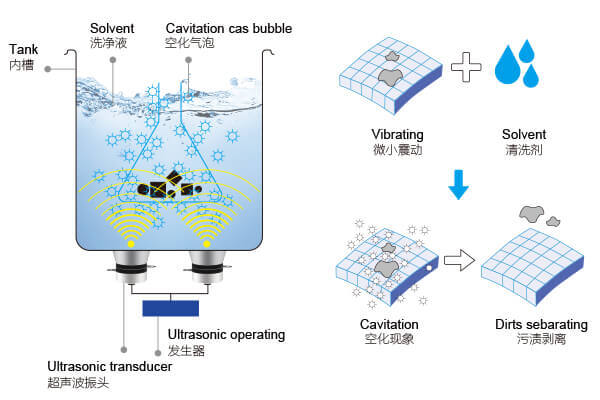
The Principle Behind Ultrasonic Cleaning
The result? Contaminants are dislodged without harsh chemicals or abrasive scrubbing. And because the bubbles form and collapse so rapidly, even fragile items—like eyeglass lenses or surgical instruments—can be cleaned thoroughly without damage, provided the right settings are used.
The Key Components of an Ultrasonic Cleaner
An ultrasonic cleaner may look like a simple box from the outside, but inside, it’s a symphony of engineering precision. Understanding the main parts can help you appreciate how these machines work—and how to choose or use them effectively.
Cleaning Tank
The cleaning tank is where the action happens. Usually made of stainless steel, it must withstand the continuous microscopic implosions of cavitation bubbles. A good tank resists corrosion, handles temperature changes, and transmits ultrasonic waves evenly. In industrial models, tanks might be double-walled for added strength and thermal insulation.

Ultrasonic Cleaner Spare Parts
Cleaning Basket
You might think: Why not just drop items into the tank? The basket prevents that. It keeps objects from touching the tank bottom, which protects both the tank (from scratching or vibration damage) and the item (from abrasion or potential damage from hotspots). The mesh design allows full penetration of cavitation bubbles.
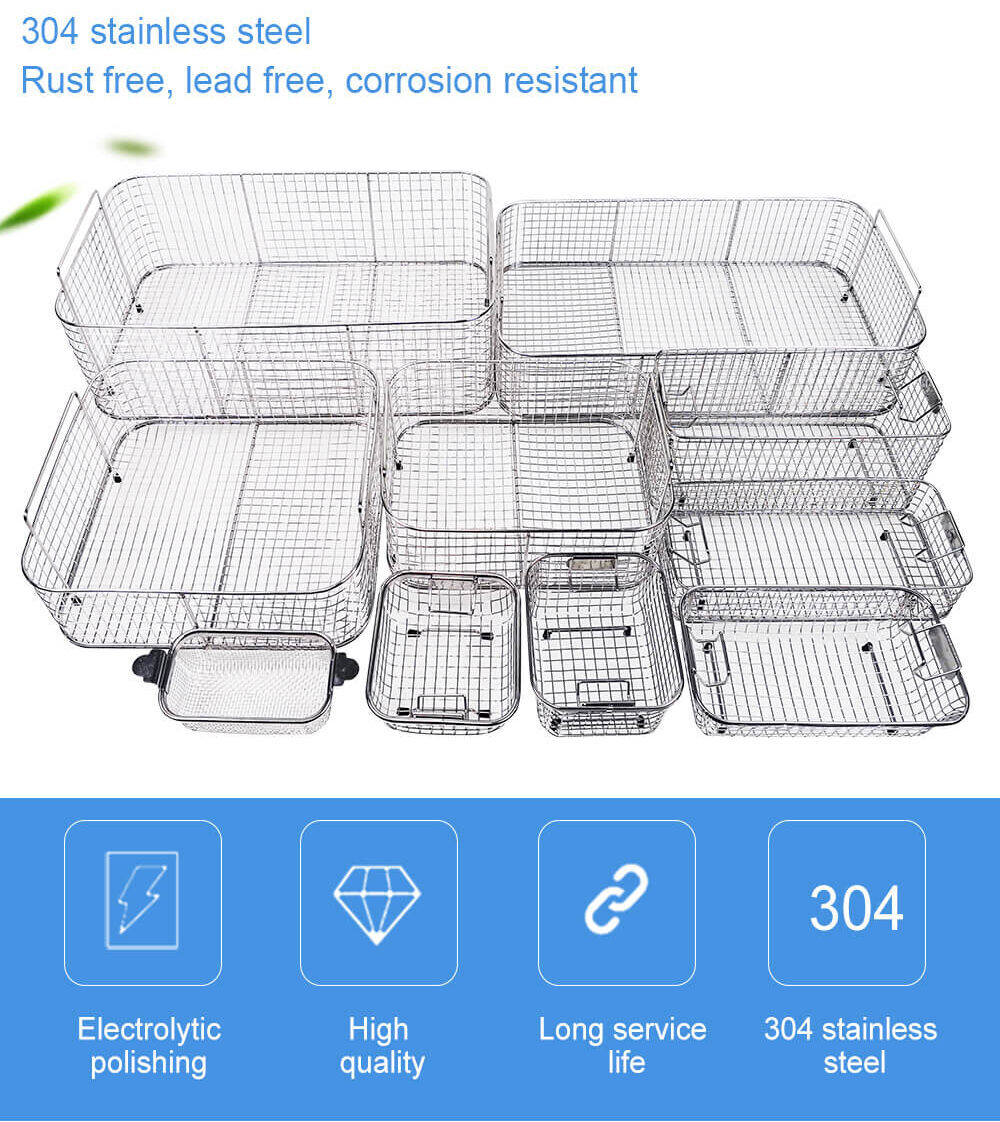
Ultrasonic Cleaner Spare Parts
Ultrasonic Generator
Think of the generator as the brain. It converts electrical power from the wall socket into the high-frequency electrical signals that drive the transducers. A high-quality generator ensures stable frequency, adjusts power delivery, and often offers modes like sweep (to eliminate dead zones) or pulse (for intensified cleaning).
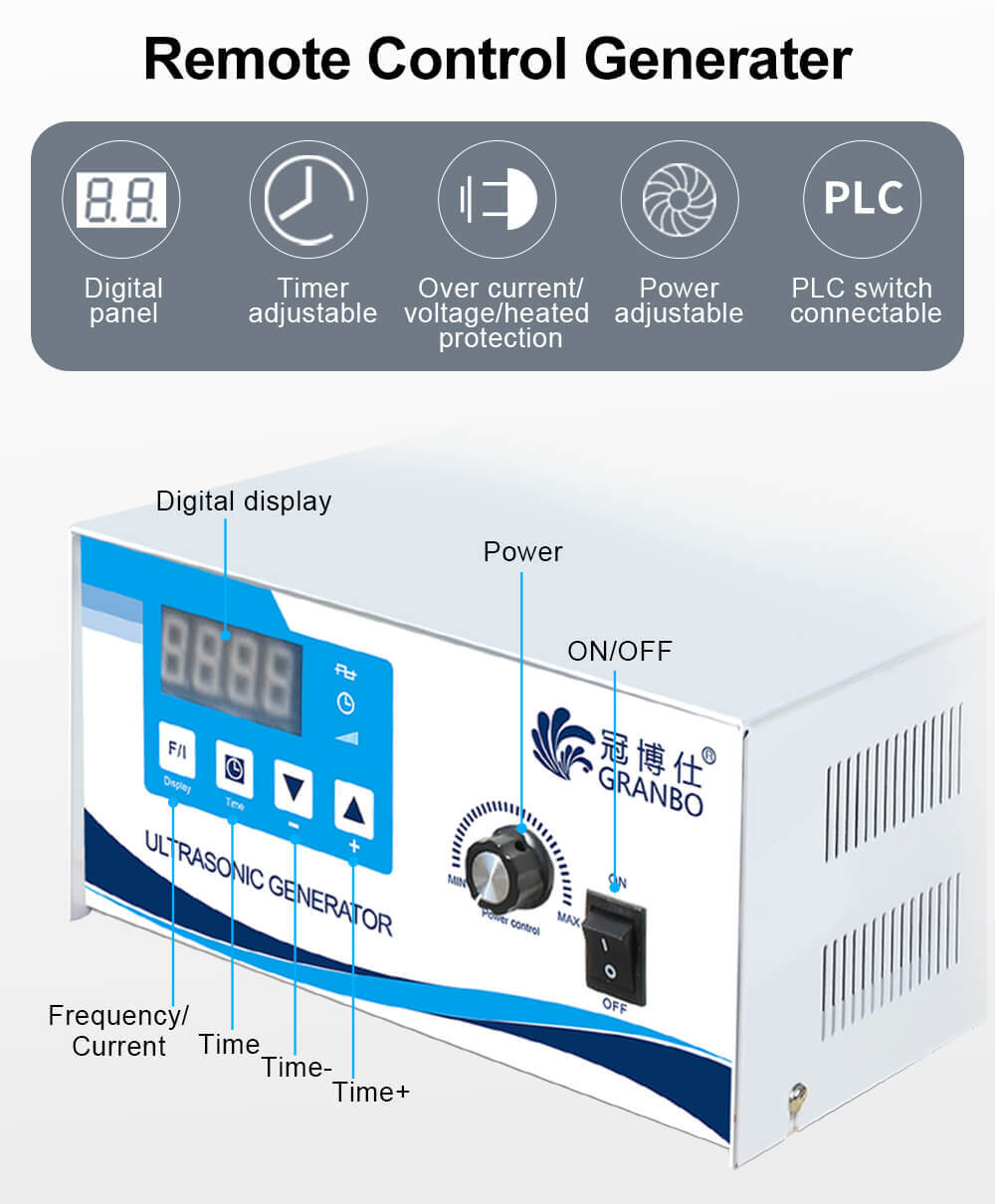
Ultrasonic Generator
Ultrasonic Transducer
This is the muscle of the cleaner. The transducer (often called “the vibrator head” in some regions) converts electrical signals from the generator into mechanical vibrations—ultrasound. These vibrations create the pressure waves that cause cavitation. Transducers are typically bonded to the underside of the tank and may be piezoelectric or magnetostrictive depending on the design.
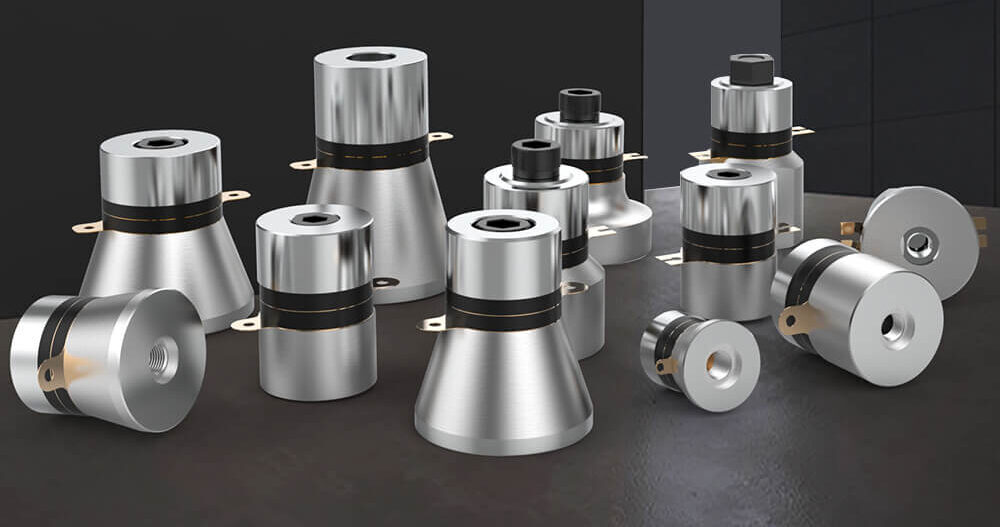
Ultrasonic Cleaner Spare Parts
Together, these parts form the engine room of ultrasonic cleaning: the generator provides the energy, the transducer turns that energy into sound waves, and the tank and basket create a safe space where cavitation can clean deeply without damaging either the machine or your valuables.
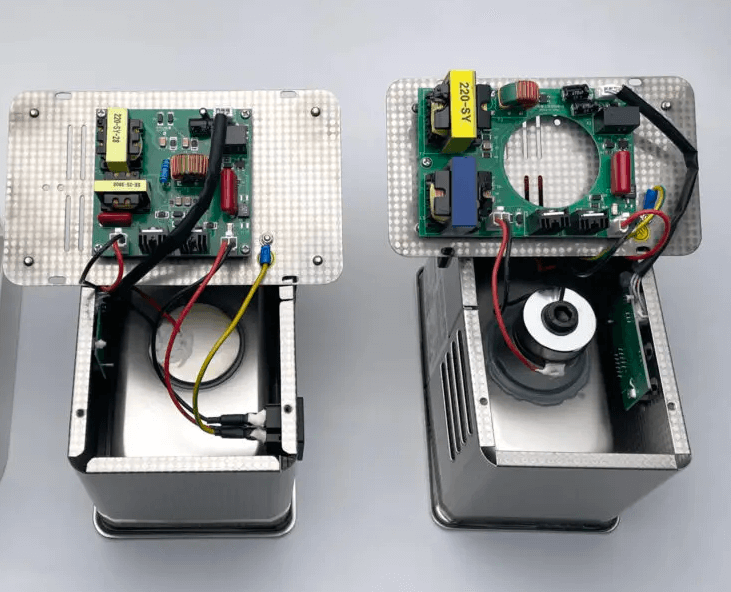
Inside a Small Household Ultrasonic Cleaner After Disassembly
The Role of Frequency, Power, and Cleaning Solution
Not all ultrasonic cleaners are created equal. The frequency of the sound waves plays a huge role in how aggressive or gentle the cleaning action is. Lower frequencies like 25 kHz create larger bubbles and more forceful cavitation, making them ideal for heavy-duty jobs like removing carbon deposits from engine parts. Higher frequencies, say 40 kHz or above, generate smaller bubbles that clean more gently—perfect for delicate electronics or jewelry.
Then there’s power. Think of it like volume. A higher-wattage machine will deliver stronger cavitation. But more isn’t always better; too much power can damage sensitive items. That’s why many professional ultrasonic cleaners offer adjustable power and frequency settings.
And let’s not forget the cleaning solution. Water alone can create cavitation, but adding the right detergent improves the process dramatically. Solutions can be tailored: alkaline cleaners for oils and grease, acidic solutions for oxides or rust, enzymatic formulas for biological residues. The solution not only helps break down contaminants but also cushions sensitive surfaces during cleaning.
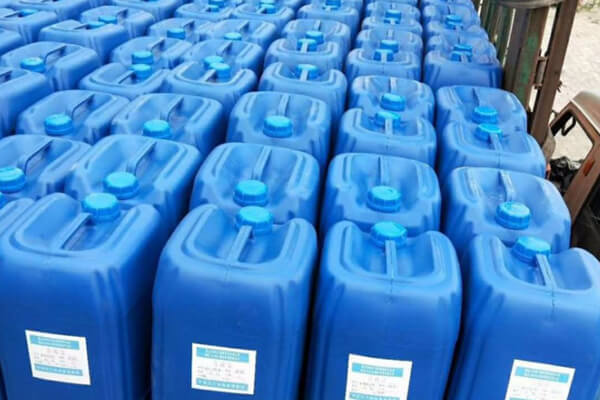
Cleaning fluid
Everyday Examples of Ultrasonic Cleaning Power
If you’ve ever had your jeweler clean your ring, odds are they used an ultrasonic cleaner. But these machines aren’t just for sparkle. Dentists rely on them to sanitize instruments between patients. In labs, ultrasonic cleaners remove residues from test tubes, pipettes, and other glassware, ensuring experiments aren’t compromised. Even watchmakers and hobbyists use them to restore fine parts to their original brilliance.
I remember the first time I used an ultrasonic cleaner at home for my eyeglasses. The frames had grime caked into the hinges, impossible to remove with cloth or brush. After a 30-second ultrasonic bath? Pristine. And no risk of bending the frame or scratching the lenses.
Are There Limits to What Ultrasonic Cleaners Can Do?
Absolutely. While ultrasonic cleaners are powerful, they aren’t magic. Certain contaminants—like heavy rust or thick, baked-on grease—may require pre-treatment. Similarly, not every material loves cavitation. Soft stones like opals, emeralds, or pearls can be damaged. Items with glued components might fall apart if the bond weakens under ultrasonic action. And despite their precision, ultrasonic cleaners need supervision; leaving something in for too long or using the wrong solution can do harm.
How to Use an Ultrasonic Cleaner for Best Results
Whether you’re cleaning eyeglasses at home or carburetor parts in a workshop, the basic steps are the same:
Fill the tank with water—distilled is better to reduce mineral buildup.
Add cleaning solution appropriate for your item: mild detergent for jewelry, enzymatic cleaner for medical tools, or a degreaser for engine parts.
Place items in the basket, ensuring they’re not overcrowded.
Set time and power: Typically, 30 seconds to 3 minutes for delicate items; longer for industrial parts.
Rinse and dry: Always rinse items well after cleaning to remove residues, and dry with a soft cloth or air blower.
What to Look for When Buying an Ultrasonic Cleaner: A Detailed Guide
If you have decided to invest in an ultrasonic cleaner, you are taking a smart step toward making your cleaning routine more efficient and thorough. However, with so many models available on the market, choosing the right one can feel overwhelming. This guide outlines key factors to consider so that you can make an informed decision and select a cleaner that truly fits your needs.
Tank Size and Shape
The size of the tank should match the items you plan to clean. Small objects like rings, eyeglasses, or dental tools can be cleaned in compact tanks ranging from about 0.6 to 2 liters. If you need to clean larger objects such as carburetor parts, tools, or laboratory equipment, you will want a tank that is at least 5 liters or more.
Shape is also important. Long or awkwardly shaped items such as dental instruments or firearm components may require a deeper or elongated tank to fit properly without overcrowding. Always measure your largest item and compare it to the usable space of the tank, not just the total volume.
Frequency and Power
The cleaning frequency affects the size and force of the cavitation bubbles produced during operation. Lower frequencies, around 25 to 30 kilohertz, generate larger bubbles that deliver a more aggressive cleaning action. This is suitable for removing heavy grime from sturdy items like automotive parts. Higher frequencies, around 40 to 80 kilohertz, create smaller, gentler bubbles that are ideal for cleaning delicate items such as fine jewelry, watches, or electronic components.
Power is just as important as frequency. Higher wattage produces stronger cavitation but can be too harsh for fragile items. A unit with adjustable power gives you flexibility to handle different types of cleaning tasks without risking damage.
Heating and Temperature Control
Some contaminants, like hardened grease or wax, dissolve more easily at elevated temperatures. Many ultrasonic cleaners come with adjustable heating that lets you set water temperatures typically between 30 and 80 degrees Celsius. Having temperature control gives you versatility for handling a range of cleaning challenges.
If you primarily clean sensitive items, you may want the option to skip heating altogether.
Timer and Cycle Control
A precise timer allows you to set appropriate cleaning durations. Too long in the tank can risk damaging delicate parts, while too short may not clean effectively. Look for models with digital timers that can be set for short cycles, typically between 30 seconds and 10 minutes. Some advanced models offer special modes like sweep or pulse to enhance cleaning performance or prevent dead zones in the tank.
Build Quality and Materials
It is always wise to choose an ultrasonic cleaner with a stainless steel tank. Stainless steel resists corrosion and handles the intense conditions generated by cavitation. For frequent or industrial use, look for models with durable construction, reinforced welding, and securely mounted transducers that will hold up under long-term use.
A reputable brand and a solid warranty add peace of mind that your investment will last.
Ease of Maintenance and Additional Features
Ease of use matters too. Look for models with drain valves for easy water changes and intuitive controls that make operation straightforward. Baskets or lids included with the unit help protect both the machine and the items being cleaned. Extra features such as degas mode for preparing cleaning solutions, memory presets, or filtration systems for industrial models can provide added convenience and performance.
Choosing the right ultrasonic cleaner ultimately comes down to matching its features to your specific tasks. Consider what you plan to clean, how often you will use it, and what level of precision you need. A good ultrasonic cleaner should offer the right balance of power, frequency, and usability so that it becomes a reliable tool rather than a source of frustration.
 Granbo Sonic
Granbo Sonic














